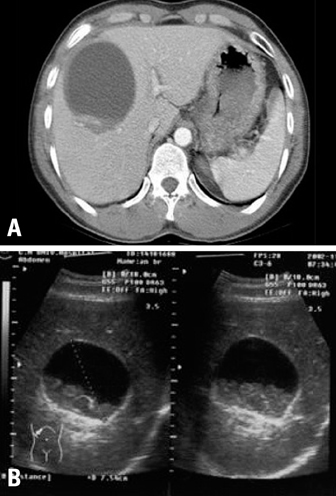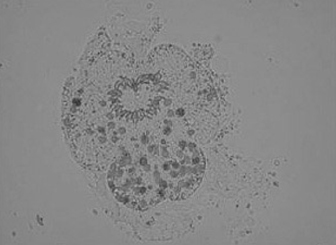Yonsei Med J.
2009 Oct;50(5):717-720. 10.3349/ymj.2009.50.5.717.
First Successful Puncture, Aspiration, Injection, and Re-Aspiration of Hydatid Cyst in the Liver Presenting with Anaphylactic Shock in Korea
- Affiliations
-
- 1Department of Internal Medicine, Chonnam National University Medical School, Gwangju, Korea. medkid@dreamwiz.com
- 2Department of Laboratory Medicine, Chonnam National University Medical School, Gwangju, Korea.
- KMID: 1103829
- DOI: http://doi.org/10.3349/ymj.2009.50.5.717
Abstract
- Hydatid disease is a parasitic infestation caused by the larval form of Echinocococcus. In human, the most commonly affected organs are liver and lung. Most cysts remain clinically silent and are diagnosed incidentally or when complications occur. In Korea, hydatid disease is rare and surgically treated cases have been reported in the Korean literature. However, it is expected to confront this disease sooner or later, because of recent increase in traveling to the endemic area and industrial workers originating from those areas. With this trend, we experienced a case of hydatid cyst of the liver in a male patient from Uzbekistan. This patient was presented with anaphylactic shock combined with hydatid cyst. We successfully treated using ultrasound-guided transhepatic percutaneous drainage [termed puncture, aspiration, injection, and re-aspiration (PAIR)] of the hydatid cyst and concomitant albendazole instead of surgery. In this clinical case report, we describe all the course of the patient and recommend the PAIR as a first choice method for treatment of hepatic hydatid cyst.
Keyword
MeSH Terms
Figure
Cited by 3 articles
-
Hepatic Hydatid Cyst: A Case Report
Wan Chul Kim, Jae Uk Shin, Su Sin Jin
Korean J Gastroenterol. 2021;77(1):35-38. doi: 10.4166/kjg.2020.129.International Travel and Imported Parasitic Diseases
Kyoung-Hwan Joo
Hanyang Med Rev. 2010;30(3):156-175. doi: 10.7599/hmr.2010.30.3.156.Overview of anaphylaxis in Korea: diagnosis and management
Gwang Cheon Jang, Yoon-Seok Chang, Sun Hee Choi, Woo-Jung Song, Soo-Young Lee, Hae-Sim Park, Hye-Ryun Kang, Yeong-Min Ye, Hyun-Jung Jin, Mi Yong Shin, Soo-Jin Lee, Hye One Kim, Jihyun Kim, Jae-Woo Jung, Hee-Bom Moon, Youngmin Ahn
Allergy Asthma Respir Dis. 2013;1(3):181-196. doi: 10.4168/aard.2013.1.3.181.
Reference
-
1. Kang MJ, Lee SH, Kim SJ, Chei YH, Park JH, Park do H, et al. [A case of multiple intraperitoneal cysts from ruptured hepatic hydatid cysts]. Korean J Gastroenterol. 2007. 50:203–206.2. Chai JY, Seo M, Suh KS, Lee SH. An imported case of hepatic unilocular hydatid disease. Korean J Parasitol. 1995. 33:125–130.3. Filice C, Brunetti E, Bruno R, Crippa FG. Percutaneous drainage of echinococcal cysts (PAIR-puncture, aspiration, injection, reaspiration): results of a worldwide survey for assessment of its safety and efficacy. Gut. 2000. 47:156–157.4. Zhang W, Li J, McManus DP. Concepts in immunology and diagnosis of hydatid disease. Clin Microbiol Rev. 2003. 16:18–36.
Article5. Seimenis A. Overview of the epidemiological situation on echinococcosis in the Mediterranean region. Acta Trop. 2003. 85:191–195.
Article6. Seo BS, Oh MY, Cho WY. An echinococcal cyst found in lung of cattle in Cheju-do. Korean J Parasitol. 1975. 13:85.7. McManus DP, Zhang W, Li J, Bartley PB. Echinococcosis. Lancet. 2003. 362:1295–1304.
Article8. Spruance SL. Latent period of 53 years in a case of hydatid cyst disease. Arch Intern Med. 1974. 134:741–742.
Article9. Gelincik A, Ozşeker F, Büyüköztürk S, Colakoğlu B, Dal M, Alper A. Recurrent anaphylaxis due to non-ruptured hepatic hydatid cysts. Int Arch Allergy Immunol. 2007. 143:296–298.
Article10. Ekrami Y. Surgical treatment of hydatid disease of the liver. Arch Surg. 1976. 111:1350–1352.
Article11. Khuroo MS, Wani NA, Javid G, Khan BA, Yattoo GN, Shah AH, et al. Percutaneous drainage compared with surgery for hepatic hydatid cysts. N Engl J Med. 1997. 337:881–887.
Article12. Smego RA Jr, Sebango P. Treatment options for hepatic cystic echinococcosis. Int J Infect Dis. 2005. 9:69–76.
Article13. Smego RA Jr, Bhatti S, Khaliq AA, Beg MA. Percutaneous aspiration-injection-reaspiration drainage plus albendazole or mebendazole for hepatic cystic echinococcosis: a meta-analysis. Clin Infect Dis. 2003. 37:1073–1083.
Article14. WHO Informal Working Group. International classification of ultrasound images in cystic echinococcosis for application in clinical and field epidemiological settings. Acta Trop. 2003. 85:253–261.
- Full Text Links
- Actions
-
Cited
- CITED
-
- Close
- Share
- Similar articles
-
- A Case of Hydatid Disease Diagnosed in Anaphylatic Shock of Unknown Cause
- Laparoscopic Management of a Hydatid Cyst of the Adrenal Gland
- Hydatid Cyst of the Orbit
- Anaphylactic shock caused by intramuscular injection of midazolam during the perioperative period: a case report
- Aspiration and Sclerotherapy with 95% Ehtanol for Simple Renal Cyst



